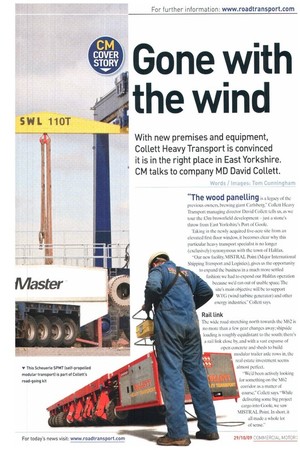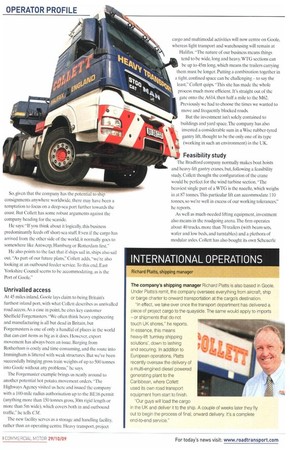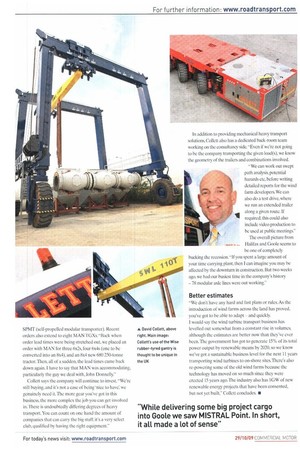Gone with the wind
Page 39

Page 40

Page 41

If you've noticed an error in this article please click here to report it so we can fix it.
With new premises and equipment, Collett Heavy Transport is convinced it is in the right place in East Yorkshire. CM talks to company MD David Collett.
Words images: Tom Cunningham "The wood panelling is, legacy of the previous owners, brewing giant Carlsberg," Collett Heavy Transport managing director David Collett tells us, as we tour the Om brownfleld development —just a stone's throw from East Yorkshire's Port of Goole.
'raking in the newly acquired five-acre site from an elevated first-floor window, it becomes clear why this particular heavy transport specialist is no longer (exclusively) synonymous with the town of Halifax.
"Our new facility, MISTRAL Point (Major International Shipping Transport and Logistics), gives us the opportunity to expand the business in a much more settled fashion, we had to expend our Halifax operation because we'd ran out of usable space. The site's main objective will be to support WTG (wind turbine generator) and other energy industries," Collett says.
Rail. Link
The wide road stretching north towards the M62 is no more than a few gear changes away; shipside loading is roughly equidistant to the south; there's a rail link close by, and with a vast expanse of open concrete arid sheds to build modular trailer axle rows in, the real estate investment seems almost perfect.
"We'd been actively looking for something on the M62 corridor as a matter of course," Collett says "While delivering some big project cargo into Goole, we saw MISTRAL Point. In short, it all made a whole lot of sense."
So, given that the company has the potentia to s ip consignments anywhere worldwide, there may have been a temptation to focus on a deep-sea port further towards the coast. But Collett has some robust arguments against the company heading for the seaside.
He says: "If you think about it logically, this business predominantly feeds off short-sea stuff. Even if the cargo has arrived from the other side of the world, it normally goes to somewhere like Antwerp. Hamburg or Rotterdam first."
He also points to the fact that if ships sail in. ships also sail out. -As part of our future plans," Collett adds, "we're also looking at an outbound feeder service. To this end, East Yorkshire Council seems to be accommodating, as is the Port of Goole."
Unrivalled access
At 45 miles inland, Goole lays claim to being Britain's furthest inland port, with what Collett describes as unrivalled road access. As a case in point, he cites key customer Sheffield Forgemasters."We often think heavy engineering and manufacturing is all hut dead in Britain, but Forgemasters is one of only a handful of places in the world that can cast items as big as it does. However, export movement has always been an issue. Barging from Rotherham is costly and time consuming, and the route into Immingham is littered with weak structures. But we've been successfully bringing gross train weights of up to 500 tonnes into Goole without any problems.he says.
The Forgemaster example brings us neatly around to another potential hot potato, movement orders. 'The Highways Agency visited us here and issued the company with a 100-mile radius authorisation up to the BEI6 permit (anything more than 150 tonnes gross, 30m rigid length or more than 5m wide), which covers both in and outbound traffic," he tells CM.
The new facility serves as a storage and handling facility, rather than an operating centre. Heavy transport, project cargo and multimodal activities will now centre on Goole, whereas light transport and warehousing will remain at Halifax. "The nature of our business means things tend to be wide, long and heavy. WTG sections can be up to 45m long, which means the trailers carrying them must be longer. Putting a combination together in a tight, confined space can be challenging to say the least," Collett quips. "This site has made the whole process much more efficient. It's straight out of the gate onto the A614, then half a mile to the M62. Previously we had to choose the times we wanted to move and frequently blocked roads.
But the investment isn't solely contained to buildings and yard space.The company has also invested a considerable sum in a Wise rubber-tyred gantry lift, thought to he the only one of its type (working in such an environment) in the UK.
Feasibility study
The Bradford company normally makes boat hoists and heavy-lift gantry cranes, but, following a feasibility study. Collett thought the configuration of the crane would be perfect for the wind turbine section. "The heaviest single part of a WIG is the nacelle, which weighs in at 87 tonnes. This particular lift can accommodate 110 tonnes, so we're well in excess of our working tolerances," he reports.
As well as much-needed lifting equipment. investment also means in the roadgoing arena. The firm operates about 40 trucks, more than 70 trailers (with beam sets, wafer and low beds, and turntables) and a plethora of modular axles. Collett has also bought its own Scheuerle SPMT (self-propelled modular transporter). Recent orders also extend to eight MAN TGXs."Back when order lead times were being stretched out, we placed an order with MAN for three 6x2s, four 6x4s (one to be converted into an 8x4), and an 8x4 new 680 250-tonne tractor. Then, all of a sudden, the lead times came back down again.! have to say that MAN was accommodating, particularly the guy we deal with, John Donnelly."
Collett says the company will continue to invest. "We're still buying, and it's not a case of being 'nice to have', we genuinely need it. The more gear you've got in this business, the more complex the job you can get involved in.There is undoubtedly differing degrees of heavy transport. You can count on one hand the amount of companies that can carry the big stuff; it's a very select club, qualified by having the right equipment."
In addition to providing mechanical heavy transport solutions, Collett also has a dedicated back-room team working on the consultancy side. "Even if we're not going to be the company transporting the given load(s), we know the geometry of the trailers and combinations involved.
We can work out swept path analysis, potential hazards etc, before writing detailed reports for the wind farm developers. We can also do a test drive, where we run an extended trailer along a given route. If required, this could also include video production to be used at public meetings,"
The overall picture from Halifax and Goole seems to be one of completely bucking the recession. "If you spent a large amount of your time carrying plant, then I can imagine you may be affected by the downturn in construction. But two weeks ago. we had our busiest time in the company's history —78 modular axle lines were out working.
Better estimates
"We don't have any hard and fast plans or rules. As the introduction of wind farms across the land has proved, you've got to he able to adapt — and quickly.
I would say the wind turbine transport business has
A David Collett, above levelled out somewhat from a constant rise in volumes, right. Main image: although the estimates are better now than they've ever Collett's use of the Wise been. The government has got to generate 15% of its total rubber-tyred gantry is power output by renewable means by 2020, so we know thought to be unique in we've got a sustainable business level for the next 11 years the UK transporting wind turbines to on-shore sites. There's also
re-powering some of the old wind farms because the technology has moved on so much since they were erected 15 years ago. The industry also has 1GW of new renewable energy projects that have been consented, but not yet built." Collett concludes. a








































































































































